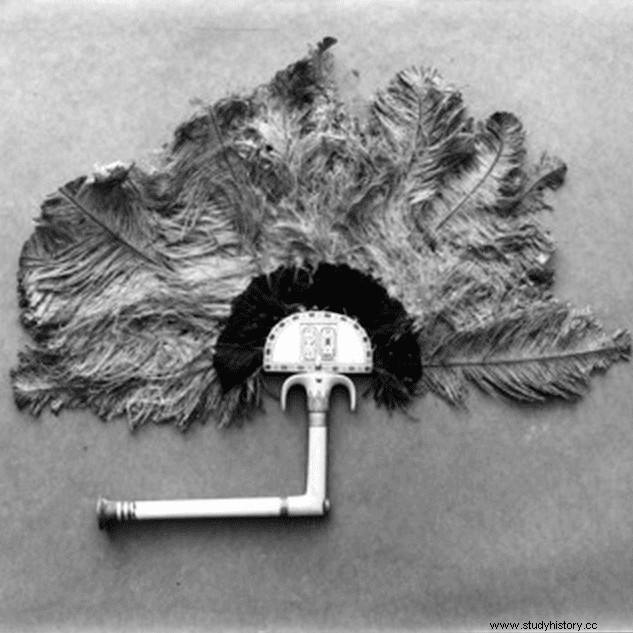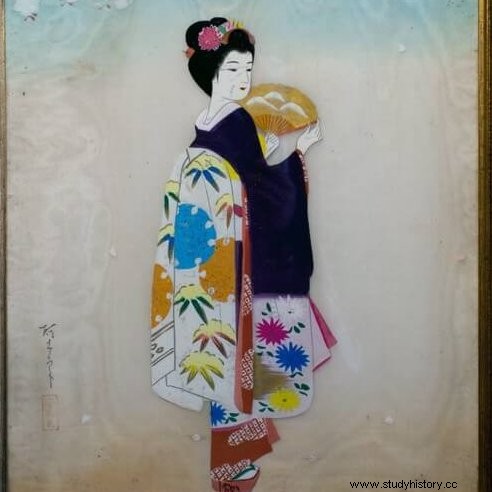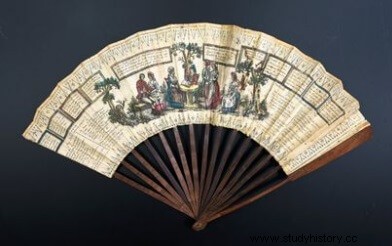Author:Clementine
A nerdy accessory or an object of luxury and refinement, the fan was one of the most useful tools during this summer's heat wave. In wood, fabric or paper, for men and women alike, it has crossed the ages and fashions. Today, the fan is a very useful accessory in the bag. However, it once had social, political or even military functions depending on the country. From Egypt, to Japan via Spain and France. I propose for this article to discover the History and the Language of the fan around the world.
Sully Prud’homme’s fan (circa 1890):
I subdue the zephyr
To my graceful beats;
O women, sometimes I attract him
Vibrant and cooler on your eyes,
Sometimes I take it on the way
And I make the tender captive
Who caresses your face
With a slow, warm, plaintive breath.
It is I who carry in your ear,
In a shiver of your hair,
The sigh that makes her red,
The burning sigh of confession;
I'm the one causing you,
And helps you conceal
Or your laugh that doesn't care
Or your tears that he makes flow.
History of the fan around the world
First stop, the fan among the pharaohs
The oldest fans are known from ancient Egypt . Eight fans were found in the royal tomb of one of the most famous pharaohs in the world:Tutankhamun . Archaeologists have also found representations on the painted walls of tombs.
Of different sizes, often made of feathers and precious stones, the fans are given to the most influential people in society. Indeed, they are the symbol of their powers, objects of great value exclusively reserved for the royal family or military officers (the more the fan is decorated, the more the person is influential). They are often found in royal tombs, sources have unearthed that its movement restored the breathing of the deceased person. Thus, the life of the deceased became more pleasant in the afterlife.

Find out more :
The Flabellum is the ceremonial fan surrounding the pharaoh during religious ceremonies. It is a large fan made of peacock or ostrich feathers fixed on a long pole used to fan the high dignitary whom one accompanied. This function quickly gave way to another more symbolic role, a manifestation of power .

And among the Greeks? Fly hunts!
In Ancient Greece, the fan or the “rhipis” is in the shape of a branch (palm tree, acacia or myrtle). It was mainly used to drive away the flies that invaded the altars where the offerings for the Gods are placed.
A stopover in the land of the rising sun:the history of the fan in Japan
It is difficult to give the date of introduction of the first fan in Japan . It has always been used by the population in the kitchen (for maintaining the fire) or by the army. There are two types of Japanese fans:“uchiwa (fixed) and the "ogi (folding). Their frames are made from wood and painted leaves. The ogi is mainly used by men.
In the Middle Ages, the "Shogun (army leader) used the fan as a war accessory to lead the troops . The "gunsen is a fan with a steel frame, its white sheet is decorated with a red circle.

Open, the gunsen gave a rallying sign or the direction of the soldiers to follow, closed it signifies guard and protection.
From the Edo period, fans were used as advertising tools (this is still the case today!). They are very popular and fashionable. They are also used for dance and martial arts!

A short stay in the Middle Kingdom:history of the fan in China
China and the fan have a long history of several millennia! Even if today China is known for the manufacture of low quality objects, the traditional craft of fan manufacturing dates from the Han dynasty (since 200 years BC). The fan is above all a divine element. Gods could move through the air and cross oceans by standing on top of them.
The first fans are made of feathers. It is also interesting to note that the Chinese character for "fan" is the same as for the word "feather". Craftsmen used sandalwood. This wood was used to perfume the air when fanning and as an insect repellent. The first folding fans appeared in China during the Ming and Qing Dynasties.

The fan arrives in Europe
The first fans to arrive in Europe came straight from Japan in Portuguese trunks in the 16 th century with cargoes of spices and silks. Very quickly, it became an instrument of refinement and luxury among the nobility.
During the Renaissance, fans also represented an object of power. The greatest women in Europe have worn it, Elisabeth I st in England or Catherine de Medici in France (fashion is really imposing itself in France with Marie de Médicis, wife of Henri IV). The accessory really becomes fashionable in Europe at this time until the end of the 18th century. Catherine de Medici made it a fashionable accessory. It takes a central place in the feminine toilet (all distinguished ladies must know how to handle the fan!) It can be seen appearing on many period engravings.
The golden age of fans in the 18th century
It would be a mistake to believe that the art of the fan is only a gestural art, it is also an element of representation with the subject that adorns the object. Indeed, the fans have a particular meaning, they are opened from left to right always to show the decorated side towards the interlocutor. Revealing a subject is very important! It bears witness to its political, religious, mythological or military interest. It can also represent a passage of his personal life through particular scenes, such as engagements, marriages or even a death. The fan is also a precious object that we offer. English, Italian and French craftsmen make it an object of art, the materials are always very precious:precious stones, mother-of-pearl, ivory, etc.
A small forced stop in France
At its peak in the 18 th century, the French Revolution marked a brutal turning point for the fan. They become the perfect support to represent testimonies of current events (at the time). They become reflections of opinions. The fan "sur l'air de la Carmagnole", you can see a woman wearing the Phrygian cap, taken from the edge of the fan of the revolutionary song La Carmagnole written in 1792 during the fall of the monarchy.

After the Revolution, fashion became more sober and lighter. Say goodbye to wigs, fly on your face , basket dresses, and other styles of all kinds, Antiquity is in fashion. Under the Empire, the range is reduced. There is no more historiated decoration but sequins which are sewn on it. It is no longer seen as an art object. During the Old Regime, you had to stand out, this is no longer the case during the Empire.
It's impossible to finish our world tour without a quick stop in Paris!
Who does not know the language of the fan? According to some, it was invented by a few ladies who were very bored in their living room to be able to chat with each other. However, no source has been uncovered retracing these anecdotes. In reality, the language of the fan is pure fiction invented by the luxury company Duvelleroy in the 19th century. Very elaborate and codified, this tool would actually be a marketing tool to relaunch the fan fashion. The company supplied the fans to the greatest ladies of the time, Queen Victoria, the Empress of Russia… The upper middle class also appreciated these fans. Lace, silk, pearls or feathers, more than ten craftsmen work on it! Gradually, the company conquered the name of the "king of fan makers". She tries to democratize the use of the fan by industrializing its manufacture. Maison Duvelleroy still exists today and continues to offer the most refined pieces.

Terminus, everyone get off in Spain!
It was in Spain that production developed in the 19th century. After the French Revolution, French craftsmen left the country to settle in Spain, particularly in Valencia. The production of the city, the Real Fabrica de Abanicos becomes the largest production in Europe. These fans are used for Flamenco or theaters.
Discover the language of the fan through gestures
Do you want to speak the language of the fan? Here are some gestures that will please you!
– Pass it from one hand to the other:"I know you're looking at another"
– Put it in front of the forehead:"Don't forget me"
– Touching the edge of the fan with your finger:"I want to talk to you"
– Clapping the palm of the hand with:“Love me”
– Yawn behind the fan:"You bore me"
– Putting a finger in front of the veil:"I love you more every day"
– Closed in the right hand:“I am looking for a fiancé”
– Closed in the left hand:"I'm not single"
– Carry the fan to your heart:"I belong to you for life"
– Drop it:“I am yours”
– Make it beat very quickly:“I love you very much”
– Take the fan by the upper part:“You leave me indifferent”
- Threatening Closed Fan:"Don't be too bold"
– The fan on the heart:“I love you”
– Hit it with another object:"I'm impatient"
– Cover part of the face with:“We are being watched”
– Cover eyes with:"I'm sorry"
– Press the fan to the mouth:“Kiss me”.
Over the centuries, the appearance of the fan changed according to fashion, fixed until the end of the 16th th century, foldable in the 17 th , bent or broken in the 18 th , see art deco in the XX th ! Shapes, colors, materials have evolved as well as their uses. Today, the fan is also used as a very original means of communication, it is a sign of creativity! Today, the fan is seen more as a luxury item to display than to use because of its manufacturing cost. Nevertheless, it can come back into fashion! Elegant, refined, original and eco-friendly, it has all the capabilities to once again become the irreplaceable accessory in the handbag. It's up to us!
Our Guest Author:Clémentine

Hello everyone, my name is Clementine And like you, I am also a history buff! This has not always been the case, when I was younger I was allergic to it... I had the "hump" of history when I began to discover the Sun King, his loves, his wars and especially Versailles! Today, I try to transmit my passion on a daily basis, whether through my job as cultural manager of the Château de Thoiry or through research as a doctoral student with a study of the French nobility in the 19th century.
Sources
- Georgina Letourmy, The fan leaf, expression of art and urban society, Paris, 1670-1790 , Doctoral Thesis in History of Art, University of Paris I Panthéon-Sorbonne, 2006.
- Georgina Letourmy-Bordier, J. de Los Llanos, The Golden Age of the Fan. From the Sun King to Marie-Antoinette , Paris, Faton edition, 2013.
- Brie Marielle, History of the fan, Blog, 2018, [last update] 2021, https://www.mariellebrie.com/histoire-de-leventail/
- Friends of the Fan Museum, History of the fan , [last update] 2020, https://www.amis-musee-eventails.com/histoire-de-leventail/
- Fan Workshops, a breath of renewal shakes the fan , [last update] 2021 atelierdeleventail.eu › recherche_sur_eventail_bd1
- Maison Duvelleroy, History and Renaissance of a Parisian fan house , [last update] 2021, https://eventail-duvelleroy.fr/house-of-duvelleroy/


